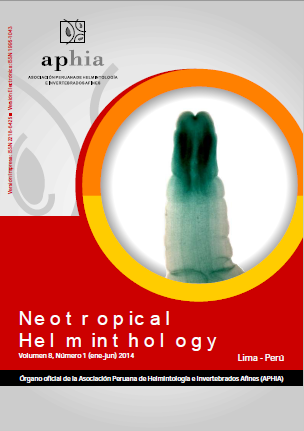PREVALENCE, INTENSITY AND ECOLOGICAL ASPECTS OF CONTRACAECUM SP. (NEMATODE: ANISAKIDAE) IN FRESHWATER FISH OF ARGENTINA
DOI:
https://doi.org/10.24039/rnh201481904Keywords:
Anisakidae larvae, Argentina, Contracaecum, ecology, freshwater fish.Abstract
The genus Contracaecum belongs to the Anisakidae family which includes parasites of considerable economic and medical importance. Larvae of Contracaecum are associated with a wide variety of freshwater and marine fish. Although there are a significant number of reports that indicate the presence of anisakid in fish from different parts of the world, there are few studies in the central region of Argentina, despite the prevalence observed in recent years. In the present study we provide new records and analyze ecological aspects of anisakid from fish of different aquatic systems with different hydrological characteristics from central Argentina.Atotal of 1402 individuals belonging to nine species, six families and four orders of fish were examinated for nematode parasites. The helminths were found in Astyanax eigenmanniorum (Characidae), Oligosarcus jenynsii (Characidae), Odontesthes bonariensis (Atherinopsidae), Hoplias malabaricus (Erythrinidae), Pimelodus albicans (Pimelodidae) and Rhamdia quelen (Pimelodidae). The last three host species showed up to 100% prevalence and maximum intensities of 162, 180 and 48 larvae/fish, respectively. All parasites found coincide with larvae of Contracaecum sp. type 2.
Downloads
Published
How to Cite
Issue
Section
License
Copyright (c) 2021 Neotropical Helminthology

This work is licensed under a Creative Commons Attribution-NonCommercial-NoDerivatives 4.0 International License.
OBJETO: El AUTOR-CEDENTE transfiere de manera TOTAL Y SIN LIMITACIÓN alguna al CESIONARIO los derechos patrimoniales que le corresponden sobre la (s) obra(s) tituladas: xxxxxxxxxxxxxxxx, por el tiempo que establezca la ley internacional. En virtud de lo anterior, se entiende que el CESIONARIO adquiere el derecho de reproducción en todas sus modalidades, incluso para inclusión audiovisual; el derecho de transformación o adaptación, comunicación pública, traducción, distribución y, en general, cualquier tipo de explotación que de las obras se pueda realizar por cualquier medio conocido o por conocer en el territorio nacional o internacional.
REMUNERACIÓN: La cesión de los derechos patrimoniales de autor que mediante este contrato se hace será a título gratuito.
CONDICIONES Y LEGITIMIDAD DE LOS DERECHOS: El AUTOR-CEDENTE garantiza que es propietario integral de los derechos de explotación de la(s) obra(s) y en consecuencia garantiza que puede contratar y transferir los derechos aquí cedidos sin ningún tipo de limitación por no tener ningún tipo de gravamen, limitación o disposición. En todo caso, responderá por cualquier reclamo que en materia de derecho de autor se pueda presentar, exonerando de cualquier responsabilidad al CESIONARIO.
LICENCIA DE ACCESO ABIERTO: El AUTOR-CEDENTE autoriza que manuscrito publicado en La Revista Neotropical Helminthology permanece disponible para su consulta pública en el sitio web https://www.neotropicalhelminthology.com/ y en los diferentes sistemas de indexación y bases de datos en las que la revista tiene visibilidad, bajo la licencia Creative Commons, en la modalidad Reconocimiento-No comercial- Sin Trabajos derivados –aprobada en Perú, y por lo tanto son de acceso abierto. De ahí que los autores dan, sin derecho a retribución económica, a la Asociación Peruana de Helmintología e Invertebrados Afines (APHIA), los derechos de autor para la edición y reproducción a través de diferentes medios de difusión.


 Numero 2 Volumen 19 - 2025 (versión Anticipada)
Numero 2 Volumen 19 - 2025 (versión Anticipada)














































